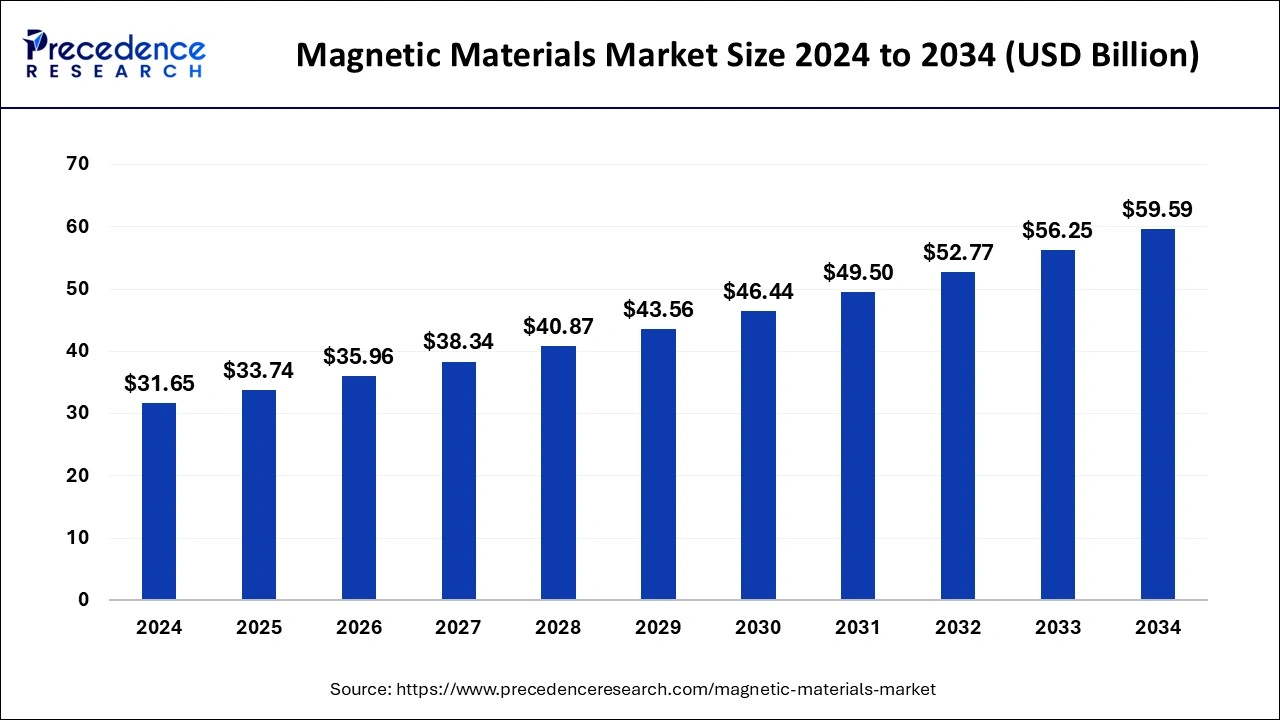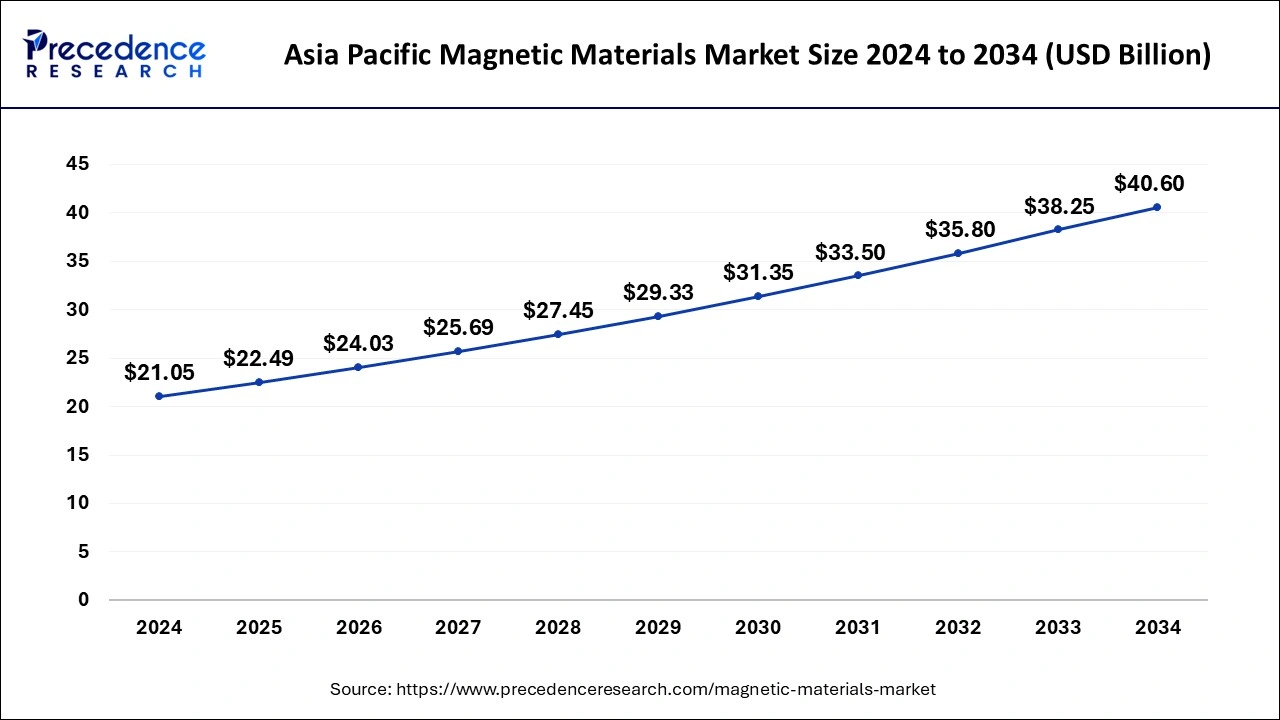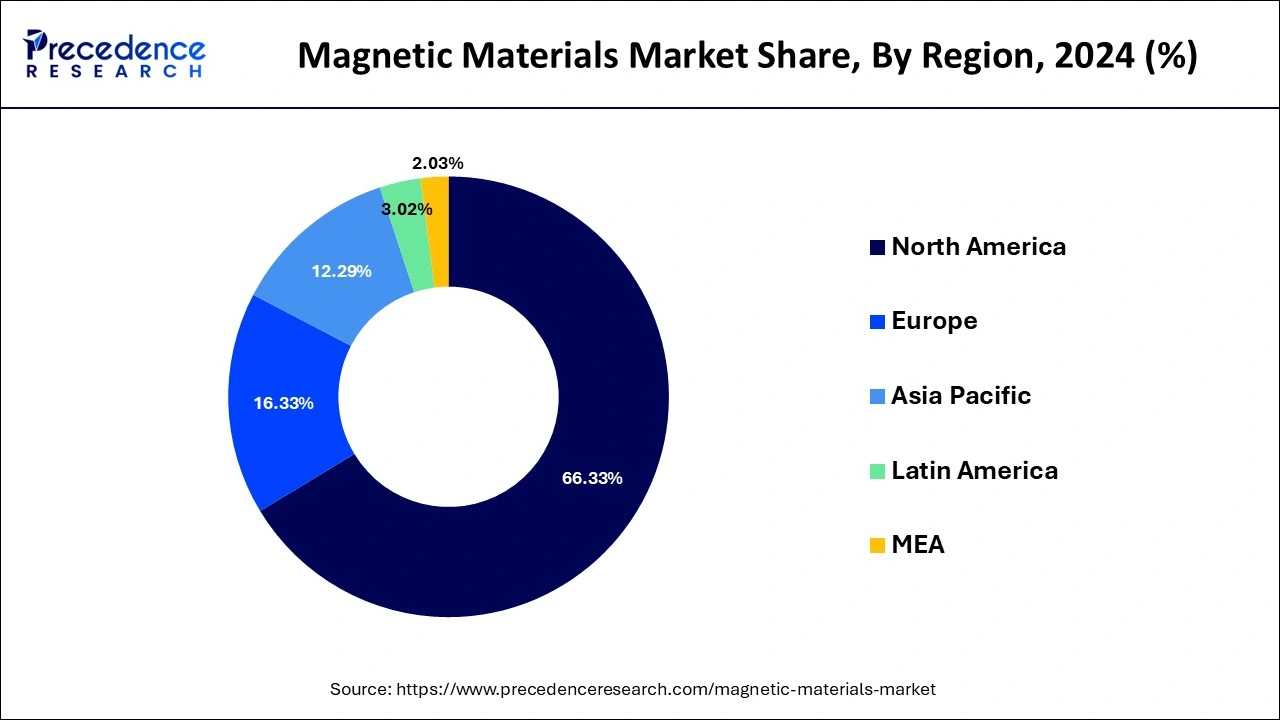List of Contents
Magnetic Materials Market Size and Forecast 2025 to 2034
The global magnetic materials market size was calculated at USD 31.65 billion in 2024 and is predicted to reach around USD 59.59 billion by 2034, expanding at a CAGR of 6.53% from 2025 to 2034.

Magnetic Materials Market Key Takeaways
- Asia Pacific led the global market with the highest market share of 66.33% in 2024.
- By geography, the North America region accounted for the majority revenue share in the market from 2025 to 2034.
- By type, the soft magnet segment is projected to have the largest market share from 2025 to 2034.
- In 2024, By application, the automotive & transportation segment held the largest revenue share of 37.0% and is expected to have the largest market share from 2025 to 2034.
- In March 2024, the Japan-based Suzuki Motor Company announced that it would invest USD 1.3 billion in an Indian factory that will make electric vehicles and electric vehicle batteries.
Asia Pacific Magnetic Materials Market Size and Growth 2025 to 2034
The Asia Pacific magnetic materials market size was exhibited at USD 21.05 billion in 2024 and is projected to be worth around USD 40.60 billion by 2034, growing at a CAGR of 6.79% from 2025 to 2034.

On the basis of geography, North America is expected to continue to be among the most alluring markets, and this region accounted for the majority of revenue share in the market throughout the projection period. Regional research predicts that North America will see considerably faster sales growth during the projection period. Magnets are now widely used in a number of local industries.
The market has increased as a result of the migration from gasoline-powered vehicles to hybrid electric vehicles with electric magnets. The region's demand for magnets is being driven by the rapid expansion of wind energy and the consumer electronics sector.
In terms of revenue, the Asia Pacific market dominated the global market in 2024 and is predicted to grow more quickly than other regions over the projected period. This is explained by the fact that China has a sizable power generation business, and that the region has continued to invest in the electronics and automotive industries throughout the predicted period. The region's need for electric motors is also being fueled by the region's strict environmental restrictions, which have facilitated the adoption of electric vehicles. The market is expanding as a result of the rising demand for soft magnetic materials used in automotive applications such as sensors, driving motors, electric brakes, actuators, and gear shifts, among others. Its demand is anticipated to rise due to the increasing requirement for energy transmission from generators and rising industrialization.

Market Overview
Materials that are employed primarily for their magnetic properties are known as magnetic materials. The magnetic dipole moment, which is linked to the spin of a material's electrons or intrinsic angular momentum, is mostly used to analyze the magnetic response. Additionally, magnetic materials are those that are drawn to a magnet. Nickel, Iron, Cobalt, etc. are a few examples. Today, magnets are utilized in all industrial sectors. Magnets are the basis for everything from the microphone we use to automobile electric motors. In the medical field, it is now widely employed. For instance, MRI, or magnetic resonance imaging, employs strong magnets and radio waves to diagnose a range of problems inside the body. Magnets can be an ideal replacement for traditional electronic materials, as evidenced by the dynamic expansion of the electronic industry. For instance, the power-hungry transistors in microchips are being replaced by nanomagnets. In the future, it might possibly take the place of silicon, which would change the semiconductor market.
The need for magnetic materials in the automotive and electronic industries is expected to increase, fueling the expansion. Among other things, magnetic materials are utilized in magnetic separators, motors, electromagnets, transformer cores, generators, microphones, and speakers. These items also have been used in signal transmission, power adaptation, magnetic field screening, analog, and digital data storage, permanent magnets, quantum devices, and power conversion from electrical to mechanical, among other things.
Magnetic Materials Market Growth Factors
Typically, items that produce magnetic fields are made of magnetic materials. They are made up of a variety of materials that have a wide range of applications. Since magnetic materials are frequently used to generate and distribute energy, they play a significant role in numerous socio-economic factors on a global scale. The expansion of the automotive industry is one of the key drivers of the growth of magnetic materials.
- The growing demand for magnetic material in automotive.
- Increasing demand for electric motors.
Market Scope
| Report Coverage | Details |
| Market Size in 2025 | USD 33.74 Billion |
| Market Size in 2024 | USD 31.65 Billion |
| Market Size by 2034 | USD 59.59 Billion |
| Growth Rate from 2025 to 2034 | CAGR of 6.53% |
| Largest Market | Asia Pacific |
| Fastest Growing Market | North America |
| Base Year | 2024 |
| Forecast Period | 2025 to 2034 |
| Segments Covered | Type, and Application |
| Regions Covered | North America, Europe, Asia-Pacific, Latin America, and Middle East & Africa |
Market Dynamics
Drivers
- Increasing use in the energy and power sectors - The utilization of renewable energy sources has significantly increased across all countries. In addition, there has been a rise in investment in energy-efficient power generation as a result of the rising demand for electricity. Permanent magnets are crucial to the smooth running of machinery, particularly in the production of electric power, transportation, air conditioning, and telecommunications. The World Wind Energy Association's (WWEA) statistics show that wind is the renewable energy source that is growing the quickest. Due to the increased desire for lower maintenance requirements and higher energy yields throughout the anticipated time, the architecture of the wind turbine generator drive system evolved.
- Magnetic materials are in greater demand in the automotive and electrical industries - The expansion will likely be fuelled by increased demand for magnetic materials in the automotive and electrical sectors. These parts are employed in the transmission of signals, power adjustments, magnetic field screening, analog and digital data storage, permanent magnets, quantum devices, and power conversion from electrical to mechanical, among other things. The U.S. government's goal of achieving net zero carbon emissions by 2050 is expected to boost the growth of the magnetic materials market. The need for permanent magnets is projected to rise on both a national and worldwide level. Permanent magnets are also used in industrial and consumer electronics, particularly in contemporary motors and drive systems. As a result of growing investments in the energy industry, it is anticipated that demand for magnetic materials would rise at a lucrative rate. Magnets are primarily employed in the renewable energy sector and are crucial components of wind turbine generators, hybrid electric vehicles, and transaction motors in batteries.
Key Market Challenges
- High cost of magnetic materials - It is projected that one of the major obstacles halting industry growth would be changes in the price of raw materials. Price changes for products, particularly for permanent magnets, result in higher production costs for the manufacturers and have an effect on the product's quality and output. However, this is made worse by regulations and limits pertaining to the product, some main factors anticipated to restrain the global market's revenue growth over the anticipated time.
Key Market Opportunities
- Shifting more attention to growth - The major firms frequently refocus their efforts on developing novel products and enhancing their production capabilities in the magnetic material industry in order to gain a competitive edge. It is projected that the creation of magnetic materials with nanostructures would result in novel uses that significantly increase the market for magnetic materials.
Type Insights
On the basis of type, the soft magnet segment is expected to have the largest market share in the coming years period. In terms of CAGR, it is projected that soft magnet demand will increase dramatically. Demand has grown as a result of its use in motor applications, where it improves the field created by the motor winding. Soft magnetic materials outperform other materials in terms of characteristics, which lowers eddy current loss and boosts motor efficiency. One of the key market drivers is the sharp increase in demand for soft magnetic materials from the automobile sector. The increasing use of high-performance auto components including the gearbox, alternator, induction coil, and antenna core is another aspect driving demand.
Semi-hard magnetic materials are thought to be the source of the market's increased income. This is a result of the increased need for technology tools and systems utilized to create new items on a global scale. Because they are pliable and coercive, semi-hard magnetic materials are more frequently used to make car brakes.
Application Insights
On the basis of application, the automotive & transportation segment held the largest revenue share of 37.0% in 2024 and is expected to have the largest market share in the coming years period, the segment has dominated the market and it will continue to grow well in terms of revenue. The demand for magnetic materials is anticipated to rise over the next years as a result of investments in this sector. For instance, in March 2022, the Japan-based Suzuki Motor Company announced that it would invest USD 1.3 billion in an Indian factory that will make electric vehicles and batteries.
Magnetic materials are used in microphones, speakers, motors, transformer cores, electromagnets, generators, and magnetic separators among other things. Among other things, these components are used for signal transmission, power adjustment, magnetic field screening, analog and digital data storage, permanent magnets, quantum devices, and power conversion from electrical to mechanical.
Magnetic Materials Market Companies
- Daido Steel Co. Ltd.
- Tengam Engineering, Inc.
- TDK Corp
- Shin-Etsu Chemical Co. Ltd.
- Molycorp Magnequench
- Hitachi Metals Ltd.
- Arnold Magnetic Technologies Corporation
- Electron Energy Corporation
- Lynas Corporation Ltd.
Recent Developments
- In March 2015 –To expand its geographic reach and diversify its product offering, INEOS purchased BP's worldwide Aromatics & Acetyls business, which consists of 15 distinct production facilities throughout the world and 10 joint ventures.
Segments Covered in the Report
By Type
- Hard
- Semi-hard
- Soft
By Application
- Automotive & Transportation
- Electronics
- Energy
- Others
By Geography
- North America
- Europe
- Asia-Pacific
- Latin America
- Middle East & Africa (MEA)
For inquiries regarding discounts, bulk purchases, or customization requests, please contact us at sales@precedenceresearch.com
Frequently Asked Questions
Ask For Sample
No cookie-cutter, only authentic analysis – take the 1st step to become a Precedence Research client